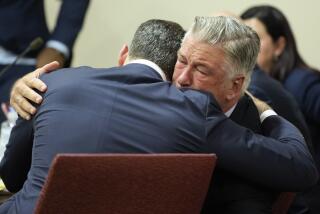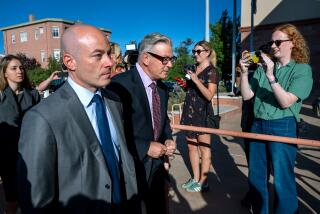Fung Recants on Glove in Simpson Trial
- Share via
Seeking to debunk a theory that he inspired, criminalist Dennis Fung on Wednesday recanted testimony he gave last week in the O.J. Simpson civil trial, insisting that no one tampered with a bloody crime scene glove.
Fung had jolted the trial when he told jurors last week that he was “not sure” the left-hand leather glove tagged as evidence in the civil trial was the same one he collected near the bodies of Nicole Brown Simpson and Ronald Lyle Goldman on June 13, 1994. He had observed a tear in the leather on the glove’s ring finger shortly after collecting it, he testified--but the glove introduced as evidence had no such damage.
The defense trumpeted that discrepancy as proof that someone replaced the actual glove with a look-alike as part of a conspiracy to frame Simpson for murder. So the plaintiffs called Fung back in their rebuttal case to tell jurors he had goofed.
Acknowledging that he found himself in a “bad spot,” Fung told jurors there was no conspiracy. “It is the same glove,” he said.
Fung, who looked downcast and drained, explained that his “memory was shaken” by an LAPD photo the defense produced showing a white mark on the glove’s ring finger a few days after the murders. He had assumed last week that the mark was a hole in the glove, he said, but added that it was actually debris clinging to the leather.
That explanation seemed to satisfy plaintiffs attorneys. But it left some unanswered questions.
Last week, Fung repeatedly told jurors that he remembered seeing some damage--which he characterized as “a rip or a cut”--underneath a chip of stucco or small rock that lay atop the ring finger of the left-hand glove at the crime scene. In fact, he testified, the rock was “embedded in a damaged area” of the leather. Fung also said last week that when he examined the gloves in his lab the day after the murders, he “found some cuts on them,” implying that both the left- and right-hand gloves were damaged.
Reading out that testimony in a voice ringing with sarcasm, lead defense attorney Robert C. Baker pressed Fung about why he had told jurors several times that the left-hand glove was damaged. Fung’s answer was simple: “I was mistaken.”
Fung has been in the hot seat before in the Simpson case. The defense blasted away at him in the criminal trial, prompting him to shift his testimony several times as he admitted giving faulty answers. In the civil case, the plaintiffs sought to shield him from such harsh treatment by limiting the scope of his testimony. But Baker called him back during the defense case and subjected him to a grilling on the glove.
The plaintiffs devoted much of Wednesday to damage control.
First, they called former FBI photo analysis chief Gerald Richards to scrutinize the white mark that appears on the glove in the crime lab photo. Richards testified that the mark was debris, not a hole. But defense attorney Daniel Leonard pointed out on cross-examination that Richards has “no way of knowing whether there’s a damaged area under that rock.”
Next up was Gregory Matheson, the assistant director of the LAPD crime lab. Matheson, too, told jurors that the white mark was debris, crusted over with dirt and encircled by a hair or fiber. And he said the glove in court has dark stains that correspond with the location and size of the blood smears visible in a photo of the glove before it was moved from the spot where police found it. Matheson also showed jurors the circles and arrows he drew on the leather to point out the bloodstains.
“Do you believe this glove here in court is the same one found in the crime scene and depicted in these photos?” plaintiff attorney Thomas Lambert asked.
“Yes, I do,” Matheson responded.
Again, however, the defense came back with a sharp cross-examination. Attorney Phil Baker pointed out that Matheson, unlike Fung, did not examine the glove for cuts either on the day after the murders or in the following weeks. Indeed, Matheson testified that his first chance to study the glove came more than three months after the murders, when he performed a serology test on four bloodstains and concluded that they were all consistent with Goldman. The glove was not sent out for DNA analysis.
While the glove debate dominated Wednesday’s court session, the two sides also sparred over photos of Simpson wearing Bruno Magli shoes, the brand that tracked bloody footprints near the bodies.
Richards acknowledged that some forgery techniques are virtually impossible to detect. Yet he insisted that he was “100% certain” that one of the photos, showing Simpson walking through the end zone at a football game, was genuine. He and FBI footwear expert William Bodziak are scheduled to testify today about 30 additional full-length photos of Simpson allegedly taken at that same game.
In yet another case of dueling photos, the plaintiffs and defense aired their fierce dispute over blood recovered from Simpson’s Bronco.
Defense attorneys touted a photo taken Aug. 10, 1994, that shows no blood on the center console--evidence of a set-up, they argue, because a stain consistent with blood from both victims and O.J. Simpson was scraped off the front, side and rear of that console weeks later, on Sept. 1.
But with Matheson on the stand, the plaintiffs showed jurors other photos taken Aug. 10 that do depict blood in at least five places in the Bronco, including the console’s rear. The plaintiffs did not produce a picture showing any blood on the console’s side or top, and Matheson acknowledged the defense’s photo shows those areas as unstained.
More to Read
Sign up for Essential California
The most important California stories and recommendations in your inbox every morning.
You may occasionally receive promotional content from the Los Angeles Times.













